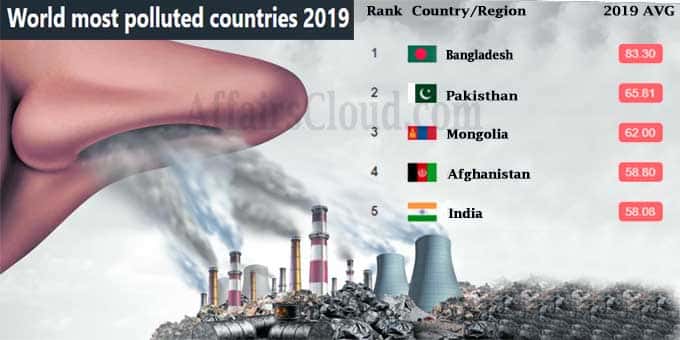In accordance with the “2019 World Air Quality Report-Region & City PM2.5 Ranking” compiled by IQAir AirVisual, India ranked 5th as the most polluted country in the world and topped in an annual list of cities with the worst air quality in the world. The report has been prepared by monitoring the real time data to tackle the urgent issue of air pollution.
- Bangladesh emerged as the most polluted country for PM2.5 exposure. It is followed by Pakistan, Mongolia, Afghanistan, and India at 2nd, 3rd, 4th and 5th place respectively.
- Of the world’s top 30 most polluted cities during 2019, 21 are located in India, 27 in South Asia, and all the top 30 cities are within greater Asia. Ghaziabad, India is the most polluted city in the world.
- Bahamas ranked 98th as the cleanest country with an average of 3 µg/m³.
- World most Polluted Countries 2019 (PM2.5): India – 5th Rank
- World most Polluted Cities 2019 (PM2.5): Ghaziabad, India – 1st Rank
- World Most Polluted Capital Cities 2019 (PM2.5): Delhi, India – 1st Rank
Reason behind this report:
IQAir strives to raise awareness of air pollution, allowing people to take action to improve air quality and protect their health.
Key Points:
i.Air Pollution estimated to contribute toward 7 million premature deaths a year, while 92% of the world’s population are estimated to breathe toxic air quality (WHO, 2016).
ii.In less developed countries, 98% of children under five breathe toxic air. As a result, air pollution is the main cause of death for children under the age of 15, killing 600,000 every year (WHO, 2018).
iii.In financial terms, premature deaths due to air pollution cost about $5 trillion in welfare losses worldwide (The World Bank, 2016).
What is PM2.5?
This focus of the report is PM2.5 concentrations- a pollutant measuring up to 2.5 microns in size, widely regarded as most harmful to human health. The microscopic size allows the particles to enter the blood stream via the respiratory system, causing far-reaching health effects, including asthma, lung cancer and heart disease.
Let’s go through the top 5 rankings under different categories of report in tabular format.
[su_table]
World most Polluted Countries 2019 (PM2.5) | ||
| Rank | Country | Average PM2.5 concentration (µg/m³) |
| 1 | Bangladesh | 83.3 |
| 2 | Pakistan | 65.8 |
| 3 | Mongolia | 62.0 |
| 4 | Afghanistan | 58.8 |
| 5 | India | 58.1 |
| 98 | Bahamas | 3.3 |
Click here to read the full list of World most Polluted Countries 2019 (PM2.5)
[/su_table]
[su_table]
World most Polluted Cities 2019 (PM2.5) | ||
| Rank | Country | Average PM2.5 concentration (µg/m³) |
| 1 | Ghaziabad, India | 110.2
|
| 2 | Hotan, China | 110.1
|
| 3 | Gujranwala, Pakistan | 105.3
|
| 4 | Faisalabad, Pakistan | 104.6
|
| 5 | Delhi, India | 98.6
|
| 4661 | Nassau, Bahamas | 3.3 |
[/su_table]
[su_table]
World Most Polluted Capital Cities 2019 (PM2.5) | ||
| Rank | Country | Average PM2.5 concentration (µg/m³) |
| 1 | Delhi, India | 98.6 |
| 2 | Dhaka, Bangladesh | 83.3 |
| 3 | Ulaanbaatar, Mongolia | 62.0 |
| 4 | Kabul, Afghanistan | 58.8 |
| 5 | Jakarta, Indonesia | 49.4 |
| 85 | Nassau, Bahamas | 3.3 |
[/su_table]
Story of India:
Progress:
-2019 marked the launch of India’s first National Clean Air Programme (NCAP) to tackle air pollution. It aims to reduce PM2.5 and PM10 air pollution in 102 cities by 20-30% by 2024 compared to 2017 levels.
-In July 2019, India additionally joined the UN’s Climate & Clean Air Coalition (CCAC) as the 65th member to collaborate with global leaders on air pollution solutions.
-Every city in India with PM2.5 data in 2018 and 2019, except for Nagpur, Maharashtra saw a decrease in PM2.5 levels in 2019.
-On the whole, air pollution in India decreased by 20% in 2019 from 2018, with 98% of cities experiencing improvements though on average, India exceed the World Health Organisation (WHO) target for annual PM2.5 exposure by 500%.
Challenges:
-Despite improvements, India still faces serious air pollution challenges.
-Report’s ranking of annual PM2.5 levels by city showed half of the 50 most polluted cities being in India.
–No Indian cities included in this report met the WHO target for annual pollution exposure (10ug/m3) during 2019.
About IQAir AirVisual:
IQAir AirVisual is a global air quality information platform operated by the IQAir Group. By aggregating and validating air quality data from governments, private individuals and non-governmental organizations, IQAir AirVisual aims to provide global and hyper-local air quality information that allows individuals, organizations and governments to take steps that improve air quality in communities, cities and countries all over the world.





